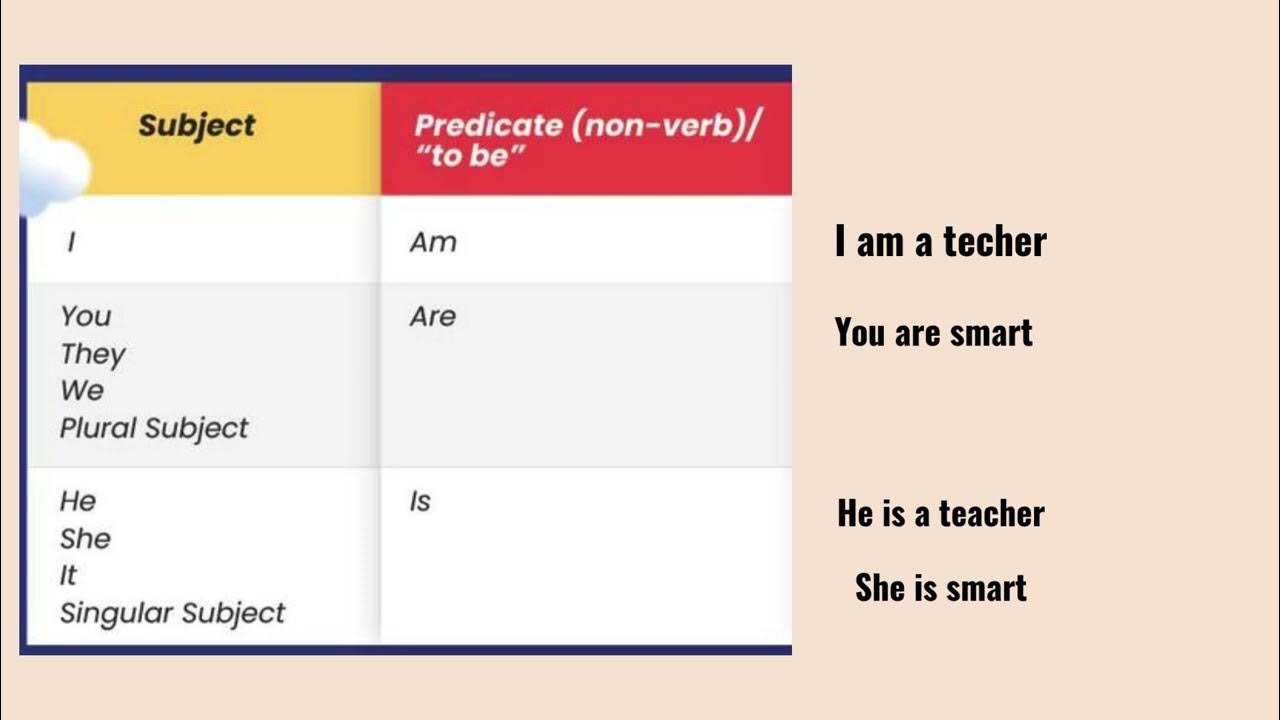Simple Present Tense I MELC-Based with Teacher Calai
Summary
TLDRIn this educational video, Teacher Kalai introduces the simple present tense, focusing on its use in scientific contexts. The lesson explains the formation of the tense for singular and plural subjects, including irregular verbs like 'be'. Examples are provided for clarity, such as 'Martha wants to be a dentist' and 'They follow instructions'. The video also covers the use of the simple present tense with pronouns like 'I' and 'you'. To reinforce learning, viewers are encouraged to practice by filling in the correct verb forms in provided sentences, making it an interactive and informative session.
Takeaways
- 😀 Simple present tense is used to describe actions happening right now or occurring regularly.
- 🔍 For singular subjects, most verbs in simple present tense are formed by adding 's' to the base form.
- 🌟 When verbs end in 'ss', 'sh', 'ch', 'x', or 'o', the simple present tense is formed by adding 'es'.
- 📘 Verbs ending in 'y' preceded by a vowel add 's' to form the simple present tense.
- 🔧 For verbs ending in 'y' preceded by a consonant, change 'y' to 'i' and add 'es' for the simple present tense.
- 📚 Plural subjects use the base form of the verb without any additional endings in the simple present tense.
- 👤 The pronoun 'I' uses the base form of the verb in the simple present tense.
- 👥 The pronoun 'you', whether singular or plural, also uses the base form of the verb in the simple present tense.
- 🌞 The verb 'to be' has different forms: 'is' for singular subjects (he, she, it) and 'are' for plural subjects (you, we, they).
- 📝 Practice exercises are provided to reinforce the understanding of simple present tense formation.
Q & A
What is the simple present tense used for in the context of the video?
-The simple present tense is used to describe actions that are happening right now or that happen regularly.
How is the simple present tense formed for singular subjects?
-For singular subjects, the simple present tense is formed by adding 's' to the base form of the verb, or 'es' if the verb ends in 'ss', 'sh', 'ch', 'x', or 'o'.
What is the rule for verbs ending in 'y' preceded by a vowel when forming the simple present tense?
-For verbs ending in 'y' preceded by a vowel, the simple present tense is formed by adding 's' to the verb.
How do you form the simple present tense for verbs ending in 'y' preceded by a consonant?
-For verbs ending in 'y' preceded by a consonant, the 'y' is changed to 'i' and 'es' is added to form the simple present tense.
What is the base form of the verb used for plural subjects in the simple present tense?
-Plural subjects take the simple or base form of the verb without any additional endings when expressing the present tense.
How does the pronoun 'I' form the simple present tense?
-The pronoun 'I' uses the base form of the verb when expressing the simple present tense.
What is the simple present tense form of the verb 'to be' for singular subjects?
-The simple present tense form of the verb 'to be' for singular subjects is 'is'.
What is the simple present tense form of the verb 'to be' for plural subjects?
-The simple present tense form of the verb 'to be' for plural subjects is 'are'.
What are some examples of activities that might be described using the simple present tense?
-Examples include daily routines like 'I run four miles every morning' or 'They follow the instructions of our leader'.
How can you practice using the simple present tense as suggested in the video?
-You can practice by writing the correct form of the verb in sentences, such as 'They speak English fluently' or 'We drink milk every morning'.
Outlines

هذا القسم متوفر فقط للمشتركين. يرجى الترقية للوصول إلى هذه الميزة.
قم بالترقية الآنMindmap

هذا القسم متوفر فقط للمشتركين. يرجى الترقية للوصول إلى هذه الميزة.
قم بالترقية الآنKeywords

هذا القسم متوفر فقط للمشتركين. يرجى الترقية للوصول إلى هذه الميزة.
قم بالترقية الآنHighlights

هذا القسم متوفر فقط للمشتركين. يرجى الترقية للوصول إلى هذه الميزة.
قم بالترقية الآنTranscripts

هذا القسم متوفر فقط للمشتركين. يرجى الترقية للوصول إلى هذه الميزة.
قم بالترقية الآنتصفح المزيد من مقاطع الفيديو ذات الصلة

KUPAS TUNTAS PERBEDAAN PENGGUNAAN VERB 1, VERB 2, DAN VERB 3 DALAM BAHASA INGGRIS

Factual Report Text | Teks Factual Report Kelas 11

B1.1 - Kurze Vergangenheit Präteritum. Schritte Plus Neu 5, Lektion 1, Teil A

ENGLISH Language Course2

SparkEnglish - Present Perfect - Affirmative - Aula de inglês

THE SIMPLE PRESENT TENSE || MATERI BAHASA INGGRIS KELAS 8 SMP/MTS SEDERAJAT
5.0 / 5 (0 votes)
